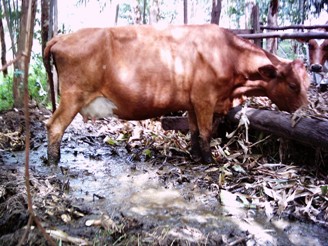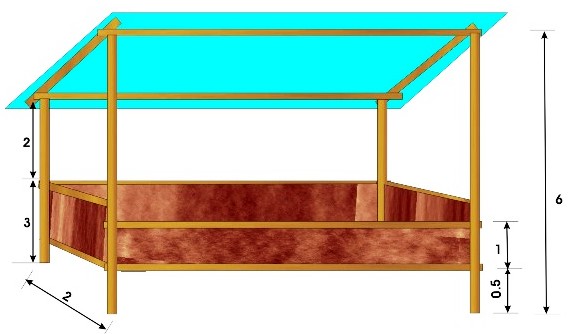Improved mobile feed troughs
Improved mobile feed troughs can be open or sheltered. Regular shifting to avoid muddy and wet conditions ensures that cattle are fed on a clean and hygienic environment. The sheltered improved mobile feed trough is better because it protects the feed and reduces losses associated with the weather.
The cost of constructing a zero grazing unit is normally high for most farmers but owing to small land sizes they are forced to raise dairy cattle in systems akin to zero grazing. But the feeding environment is usually so bad such that losses outweigh the benefits. It is estimated that about 50% offered this way is usually wasted.
Farmers have devised many ways of enclosing their animals and feeding them

there. Most of them are roofless enclosures on earth floors where feed and water troughs are provided. Some farmers just place the feeds on the ground. Accumulation of urine, dung and mud particularly in the wet season rapidly worsens the hygienic condition and predisposes the cows to pests, parasites and diseases. The animal becomes extremely uncomfortable which ultimately results in reduced milk production.
This situation need not continue because there is an affordable and better way of presenting the feeds to the cows without constructing a conventional zero grazing unit. Feeds constitute over 70% of the cost of production and all efforts should be made to improve its utilization for the farmer to realize maximum benefits. The use of improved feed trough will help the farmer to reduce the cost of feeding in the farm.
Construction of improved feeding trough
Measurements are in feet

Roof
Use a 2 or 3m iron sheets mounted on 4 pillars. It should be elevated to prevent direct sunlight and rains.
Sides
The three sides should be open and one half closed to prevent cows feeding from any direction. This is important to reduce feed losses out of cattle feeding habits. Timber or suitable local materials can be used.
Feed box
Timber is the most suitable material because of ease of cleaning. Other materials may be used. The feed trough should be large enough to contain roughage and long enough to accommodate all the animals. A spacing of 2.5 – 3.0ft (80 – 90cm) per adult animal is required.
Raise the floor of the feed troughs 6 inches (15 cm) above the floor. The inner wall should not be very high; the top should just touch the dew lap when the animal is feeding. Raise the outer wall high enough to prevent the animals approaching the feed trough from the opposite side and wasting feeds.



